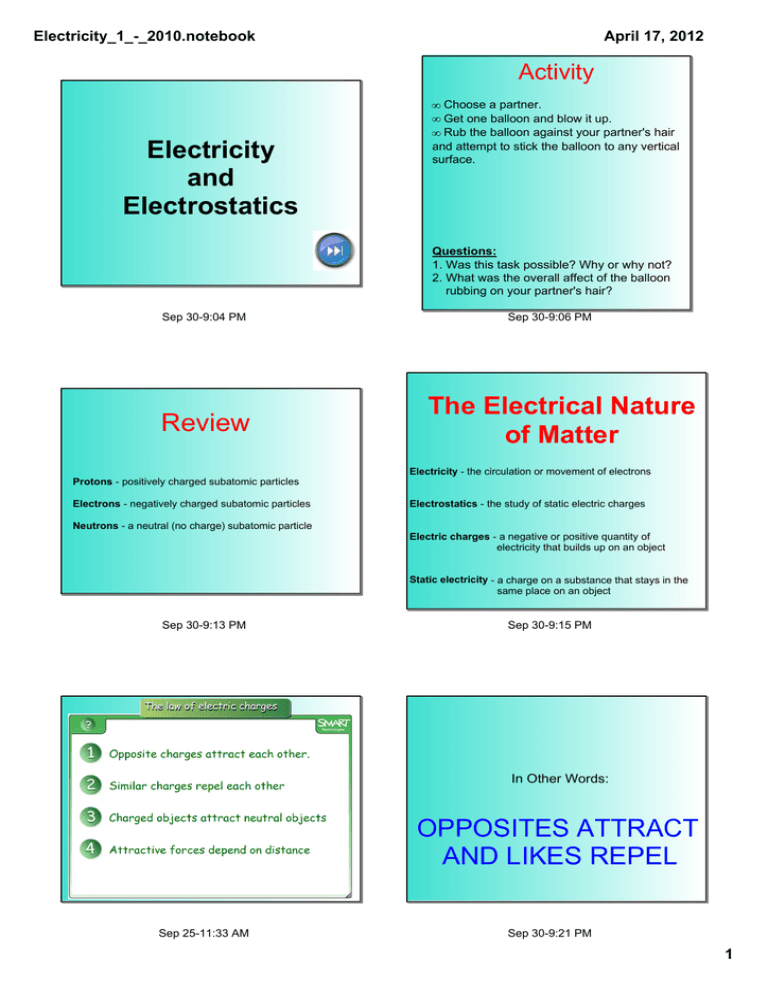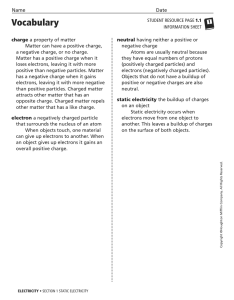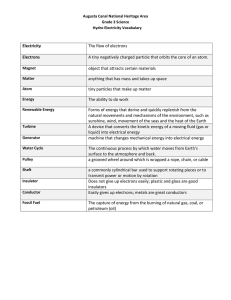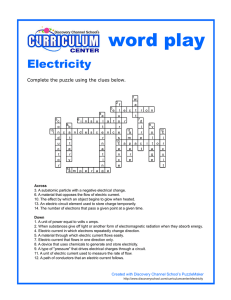Notes
advertisement

Electricity_1_­_2010.notebook April 17, 2012 Activity Electricity and Electrostatics • Choose a partner. • Get one balloon and blow it up. • Rub the balloon against your partner's hair and attempt to stick the balloon to any vertical surface. Questions: 1. Was this task possible? Why or why not? 2. What was the overall affect of the balloon rubbing on your partner's hair? Sep 30­9:04 PM Review Sep 30­9:06 PM The Electrical Nature of Matter Electricity ­ the circulation or movement of electrons Protons ­ positively charged subatomic particles Electrons ­ negatively charged subatomic particles Electrostatics ­ the study of static electric charges Neutrons ­ a neutral (no charge) subatomic particle Electric charges ­ a negative or positive quantity of electricity that builds up on an object Static electricity ­ a charge on a substance that stays in the same place on an object Sep 30­9:13 PM Sep 30­9:15 PM The law of electric charges In Other Words: OPPOSITES ATTRACT AND LIKES REPEL Sep 25­11:33 AM Sep 30­9:21 PM 1 Electricity_1_­_2010.notebook April 17, 2012 Drag the charged particles to show how they interact. Law of Electric Charges ? repulsion ? or TheCheck your answer! attraction ? or attraction May 29­10:42 AM Sep 25­11:33 AM Drag negative charges to these diagrams to illustrate a positively charged object, a neutral object and a negatively charged object. + + + + + + + + + + + + + + + + + + Postive Neutral Negative Electron Charging Objects There are three basic ways to electrically charge an object: • Charging by Friction • • Charging by Contact • • Charging by Induction Click here for the answer Nov 28­8:21 AM Transferring an electric charge from one substance to another by a rubbing action. Example: Walking across a carpet ­ creates friction between the carpet and the person's shoes produces a charge on both the person (negative) and the carpet (positive). Sep 30­9:26 PM Since all atoms do not hold onto their electrons with the same attractive force, two dissimilar materials rubbed together will fight for electrons. Drag the electrons to the material with the higher affinity. Pull here Charging by Friction Sep 30­9:23 PM Click here for the electrostatic series Neutral wool Neutral acetate Nov 28­8:21 AM 2 Electricity_1_­_2010.notebook April 17, 2012 Summary: charging by friction Neutral cotton After Before Drag the electrons to the material with the higher affinity. Neutral gold Sep 25­11:33 AM Nov 28­8:21 AM Charging by ______________ occurs when two substances are rubbed together. These two substances are initially ______________. However, after being rubbed, one object becomes _________________ while the other becomes _________________. Charging by friction occurs because ___________________ are free to move from one substance to another. The __________________________ determines which substance will ______________ electrons and which substance will ________________ electrons. Drag this to the target to reveal the answers. neutral electrons negative friction electrostatic series Click here for the electrostatic series gain lose positive Nov 28­8:21 AM If an object gains electrons then it is said to be ___________________________. If a substance loses electrons it is said to be ________________________. For example, if an ebonite rod is rubbed with a small piece of silk, the ebonite will become __________________ while the silk will become _____________. We use ________________________________________ to illustrate the transfer of electrical charge (electrons between two substances. positive negative positively charged negatively charged Drag this to Drag this to the target to reveal the answers. charge distribution diagrams diagrams Nov 28­8:21 AM Charging by Induction Charging by Contact Occurs when one object is electrically charged and passes that charge to another object. Involves transferring an electric charge from one substance to another without contact. Example: dust (neutral) sticking to your television (negatively charged). Affinity means an attractive force. Oct 12­8:44 PM Pull here Example: When you touch a doorknob after rubbing your feet across a carpet. The electrical charge from your body is shared with the doorknob. Oct 12­8:44 PM 3 Electricity_1_­_2010.notebook April 17, 2012 The Electrostatic Series Acetate Glass Wool Insulator ­ a substance in which electrons cannot move freely from one atom to another. Fur and Hair Calcium, Magnesium, Lead Silk Aluminum and Zinc GAINS ELECTRONS Cotton Insulators and Conductors Wax Conductor ­ a substance in which electrons can move freely from one atom to another. Ebonite Plastic (Polyethylene) Carbon, Copper, Nickel TASK Rubber In groups create a list of at least three conductors and three insulators. Sulfur Platinum and Gold Oct 12­8:53 PM Static Electricity and Winter Static electricity is more of a problem in winter because cold air is drier and contains fewer water molecules. Dry air is an insulator, so in winter, any static charge that builds up on our clothes or painted or polished surfaces tend to stay there. Oct 12­9:13 PM Grounding Involves a charged object sharing its charge with the ground. Oct 12­9:00 PM Discharging An Object Occurs when all the excess electrical charge is removed from an object. There are several ways to discharge an object. Discharge Methods: 1) Grounding 2) Discharge at a point 3) Exposure to air 4) Exposure to light 5) Exposure to radioactivity Oct 12­9:10 PM Discharge at a Point Removes electric charge from pointed objects by pushing the excess charge off the tip or point of the object. Often seen on aircraft. Oct 12­9:10 PM Oct 12­9:10 PM 4 Electricity_1_­_2010.notebook April 17, 2012 Ion An ion is a charged atom. Nonmetals form negative Metals form positive ions ions because they gain because they lose electrons. electrons. Zn Goes to Zn2+ O Oct 12­9:10 PM Goes to O2­ Oct 12­9:29 PM 5


